Antibody data
- Antibody Data
- Antigen structure
- References [2]
- Comments [0]
- Validations
- Immunohistochemistry [1]
- Other assay [7]
Submit
Validation data
Reference
Comment
Report error
- Product number
- PA5-43047 - Provider product page

- Provider
- Invitrogen Antibodies
- Product name
- LAPTM4B Polyclonal Antibody
- Antibody type
- Polyclonal
- Antigen
- Synthetic peptide
- Description
- Peptide sequence: YPNSIQEYIR QLPPNFPYRD DVMSVNPTCL VLIILLFISI ILTFKGYLIS Sequence homology: Cow: 93%; Dog: 100%; Guinea Pig: 100%; Horse: 100%; Human: 100%; Mouse: 100%; Rabbit: 100%; Rat: 100%
- Reactivity
- Human
- Host
- Rabbit
- Isotype
- IgG
- Vial size
- 100 µL
- Concentration
- 0.5 mg/mL
- Storage
- -20°C, Avoid Freeze/Thaw Cycles
Submitted references LAPTM4B promotes the progression of bladder cancer by stimulating cell proliferation and invasion.
Identification of Lysosome-Associated Protein Transmembrane-4 as a Novel Therapeutic Target for Osteosarcoma Treatment.
Yin Y, Fan Y, Yu G, Du Y
Oncology letters 2021 Nov;22(5):765
Oncology letters 2021 Nov;22(5):765
Identification of Lysosome-Associated Protein Transmembrane-4 as a Novel Therapeutic Target for Osteosarcoma Treatment.
Wang ZX, Guo MY, Ren J, Li GS, Sun XG
Orthopaedic surgery 2020 Aug;12(4):1253-1260
Orthopaedic surgery 2020 Aug;12(4):1253-1260
No comments: Submit comment
Supportive validation
- Submitted by
- Invitrogen Antibodies (provider)
- Main image

- Experimental details
- Immunohistochemistry (paraffin-embedded) analysis of human pineal tissue using an anti-LAPTM4B polyclonal antibody (Product # PA5-43047).
Supportive validation
- Submitted by
- Invitrogen Antibodies (provider)
- Main image
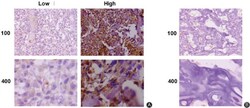
- Experimental details
- Figure 1 LAPTM4B was obviously highly expressed in osteosarcoma tissues from patients. (A) Immunohistochemistry (IHC) revealed LAPTM4B expression levels in osteosarcoma tissues and the representative images are exhibited (100x and 400x magnification, respectively). (B) IHC assays exhibited LAPTM4B expression levels in corresponding adjacent tissues and the representative images are shown (100x and 400x magnification, respectively).
- Submitted by
- Invitrogen Antibodies (provider)
- Main image
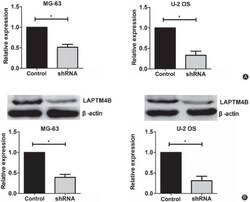
- Experimental details
- Figure 2 The expression levels of LAPTM4B were obviously decreased in both MG-63 and U-2 OS cells after the transfection of LAPTM4B-targeted shRNA plasmids. (A) The results of quantitative PCR assays showed the obviously reduced expression levels of LAPTM4B in its short hairpin RNA (shRNA) plasmid-transfected MG-63 and U-2 OS cells, respectively. (B) Immunoblot assays revealed the efficient decrease of LAPTM4B expression levels after the transfection of its shRNA plasmids in both MG-63 and U-2 OS cells. Results are presented as mean +- SD, * P < 0.05.
- Submitted by
- Invitrogen Antibodies (provider)
- Main image
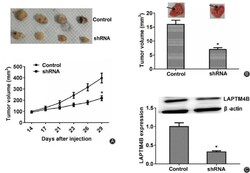
- Experimental details
- Figure 4 LAPTM4B contributes to tumor growth and metastasis of osteosarcoma cells in mice. (A) MG-63 cells infected with control or LAPTM4B short hairpin RNA (shRNA) lentivirus were subcutaneously implanted into nude mice. After 2 weeks, tumors were isolated and photographed, and the volume of tumors was measured every week ( n = 4 in each group). The tumor growth curves were calculated and analyzed according to the average volume of five tumors in between LAPTM4B knockdown and control groups. (B) MG-63 cells infected with control or LAPTM4B shRNA lentivirus were sequentially implanted into the caudal vein of nude mice. Eight weeks later, tumors were isolated from mice and the metastasis volume was calculated in each group ( n = 5 for each group). (C). Western blot assays were performed and exhibited the expression levels of LAPTM4B in control or knockdown group tumors isolated from mice. Results are presented as mean +- SD, * P < 0.05.
- Submitted by
- Invitrogen Antibodies (provider)
- Main image
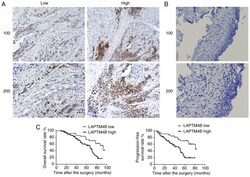
- Experimental details
- Figure 1. LAPTM4B is associated with the prognosis of patients with bladder cancer. (A) IHC was performed and representative images of LAPTM4B expression in bladder tumor tissues are shown. Magnification, x100 and x200. (B) IHC showed the expression level of LAPTM4B in the adjacent non-tumor tissues. Magnification, x100 and x200. (C) The Kaplan-Meier survival analysis of overall survival and progression-free survival rates between LAPTM4B low and high expression groups. IHC, immunohistochemistry; LAPTM4B, lysosome-associated transmembrane protein 4beta.
- Submitted by
- Invitrogen Antibodies (provider)
- Main image
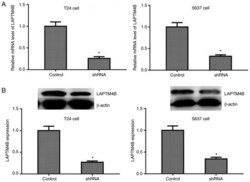
- Experimental details
- Figure 2. LAPTM4B expression was effectively knocked down in both the T24 and 5637 human bladder cancer cell lines from the transfection of LAPTM4B shRNA. (A) Quantitative PCR and (B) western blot analysis revealed the significantly reduced mRNA and protein expression levels of LAPTM4B following transfection with target shRNA in the T24 and 5637 cell lines, respectively. The results are presented as the mean +- SD. *P
- Submitted by
- Invitrogen Antibodies (provider)
- Main image
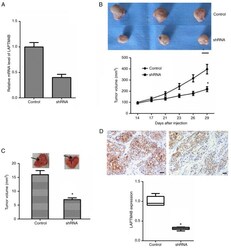
- Experimental details
- Figure 4. LAPTM4B knockdown impairs bladder cancer growth and development in vivo . T24 cells transfected with LAPTM4B or control shRNA plasmids were implanted into nude mice. After 2 weeks, the tumors were isolated and the volume was calculated each week. n=6 in each group. (A) The mRNA expression levels of LAPTM4B in control and LAPTM4B knockdown tumors. (B) Tumor images are shown and the growth curves were calculated based on the average volume of 6 tumors in each group. Scale bar, 5 mm. (C) Lung metastasis was performed and the representative images of the lungs in the control or LAPTM4B shRNA groups are shown. (D) Immunohistochemistry was used to determine the expression level of LAPTM4B and the staining intensity in the control or LAPTM4B knockdown tumor tissues, isolated from mice was determined. Scale bar, 0.5 mm. The results are presented as the mean +- SD in (A-C) and mean +- range in (D). *P
- Submitted by
- Invitrogen Antibodies (provider)
- Main image
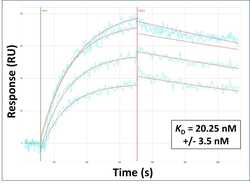
- Experimental details
- Surface Plasmon Resonance of LAPTM4B polyclonal antibody (Product # PA5-43047). Purified polyclonal antibodies were immobilized on a Protein A/G coated Carterra LSA sensor chip at concentrations of 5, and 50 µg/mL in duplicate. Antibodies on the surface were exposed to interaction with peptides sequentially via microfluidic controlled flow at 333 nm peptide concentration for kinetic characterization of the binders for affinity and specificity, followed by curve fitting using the Kinetics software. Kd determinations for both concentrations were averaged and results and standard deviation are shown.
 Explore
Explore Validate
Validate Learn
Learn Western blot
Western blot Immunohistochemistry
Immunohistochemistry